Cinematographer Florian Hoffmeister, BSC, discusses his work on the TV series “The Terror”
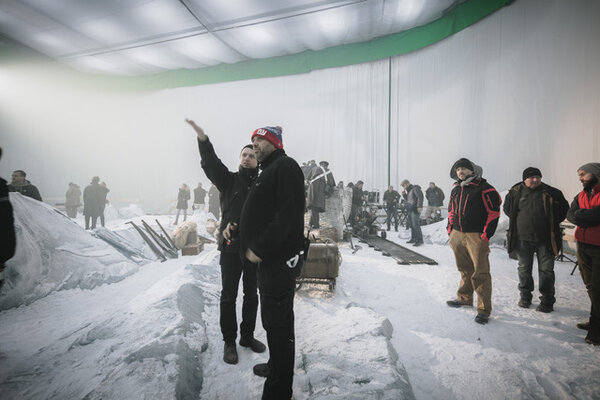
Why were you chosen to film this series?
Florian Hoffmeister: I came to work on this project thanks to German director Edward Berger, whom I’ve known for a very long time. Besides, I’ve got a good relationship with the AMC Channel because of my work as a cinematographer on television series, namely on the remake of “The Prisoner,” which I shot for them in 2009. They quickly decided to entrust me with the cinematography on the first two episodes directed by Edward, and with the tone of the entire project.
Since I hadn’t personally read Dan Simmon’s book, I discovered the story by reading the screenplay adaptation by David Kajganich and Soo Hugh. I also wondered whether I should read the book afterwards, but in the end, I decided not to.
![Director Edward Berger, Florian Hoffmeister, BSC, and camera operator Marton Ragalyi on location in Croatia] - Photo : Aidan Monaghan](local/cache-vignettes/L600xH400/terror_101_am_0412_0302-4d9d1-10b19.jpg?1711119170)
Where did you shoot?
FH: The decision to shoot in Budapest was made based on tax and financial reasons. When I arrived on the project, Jonathan Mc Kinstry, the set designer, had been hired a few weeks prior and was working tirelessly on the set design. Almost the entire series was filmed in studio, except for a few outdoors scenes shot on the Island of Pag in Croatia. This was an interesting artistic challenge for me, because I had to recreate Arctic light out of thin air, with total control over the image. The capital of Hungary is host to many international shootings. They’re well-supplied in terms of equipment and studios. But when we started to shoot the series there, the shooting of Denis Villeneuve’s Blade Runner 2049 was also being shot at the same time, and it was taking up a large portion of the available resources. We had to fall back on an empty hangar inside of which a 1/32 replica of the HMS Terror was constructed. It was a set whose realism was pretty incredible and literally transported us back in time. We were so impressed by how ingenious the engineers back then were on those exploration vessels.
Besides the fact that these ships were able to cross oceans and resist being trapped in by ice, they also literally transported a little bit of England on board, with porcelain dishes, a library, and of course all of the navigation and survival equipment. In order to simulate the flotation of the ship, and especially its list, as it progressively travels further into the ice, the set had to be mounted on a system of gimbals that enabled us to tilt it up to 30°. The upper deck was very high up in the hangar, which made the outdoor lighting harder for me because of the relative lack of ceiling clearance.
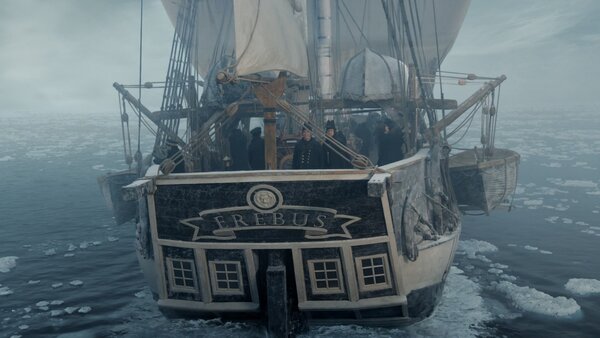
How did you light the set?
FH: I decided on a 100% LED set up. That way, I could adjust the colour very precisely according to my needs and even create moving lights on certain takes, as though the clouds were passing in front of the sun. We ended up with 600 SkyPanels on set, all of which were controlled by a console that was able to take the set from day to night in a few seconds. After digital cameras, this is the second biggest revolution in modern cinematography. It’s hard for me to imagine now how we would have been able to shoot as quickly on this project with classic lights like SpaceLights, not to mention the gelatine budget that would have literally exploded! For the sun, I used a 20kW MoleBeam (tungsten bulb and clear lens) that we could place at an angle to create the long shadows that are characteristic of Arctic light at the beginning or end of winter.
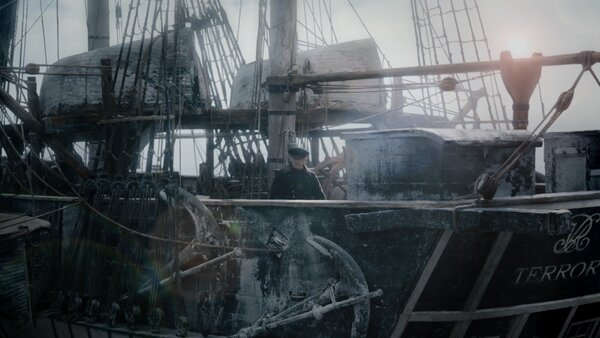
What were your visual references?
FH: During our preparatory discussions, Edward and I agreed on a contemporary and mysterious style instead of the romantic or imperial style adopted by most films that are set in the Victorian era. A dark image with contrast and faded colours. As we progressed through our tests, I often remembered the bleach bypass development processes we used to use in the 1990s that were intended to keep a part of the silver in the emulsion, thereby modifying the development of the negative. The result was muted colours, strong contrast and texture on screen, with a more-visible graininess on the film. Working with the Colorfront team in Budapest—they’re amongst the veterans of digital colour timing—we developed a method for treating the images that very faithfully imitated bleach bypass silver-process development. We used a number of films that had used that technique as references, including Spielberg’s Lincoln, cinematography by Janusz Kamińksy, ASC. As I know from experience that there can be a lot of variation in terms of image control in the digital postproduction chain, I insisted that this treatment be applied during shooting on set, and that it be followed throughout the entire postproduction chain, from editing to special effects, with a perfect colorimetric timing at each step of the chain.
I’ve personally suffered too often from digital images that were taken without a firm intent for their colour timing, and which, as editing progressed, became transformed into something opposite, and very different from the reference that film used to provide.

Did the broadcaster dictate your equipment choices?
FH: As for the camera, AMC requires a HD 16/9 format, but without any further constraints, unlike Netflix. Therefore, on paper, the production did not want to shoot with cameras that were 4K or 6K capable. Nonetheless, in terms of digital cinematography, resolution goes hand-in-hand with the size of the sensor. My feeling during preproduction was that we should shoot with a wide-sensor camera, such as the RED Dragon, so that we would be able to use longer-focal-length lenses on set, while at the same time maintaining a relatively wide angle.
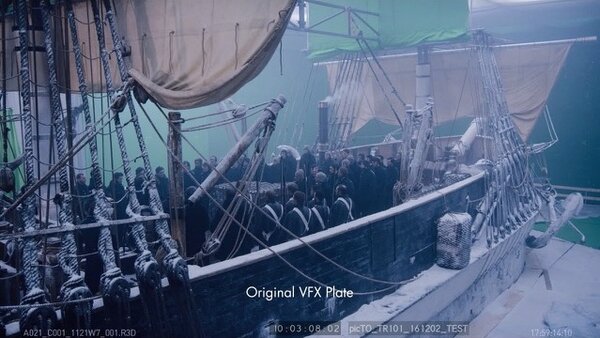
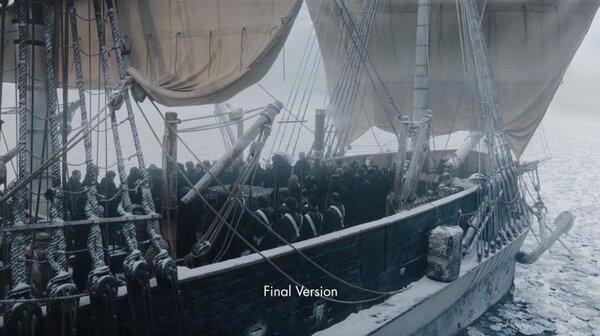
What was your most difficult challenge?
FH: The trade-off of imitating a bleach bypass process was that we had to increase the lighting on set. Just like when you work with silver-process film, the more the contrast increases, the more the real sensitivity decreases. That was especially the case in the inside areas of the ship. To correct it, we dispatched the light sources in three “layers”: first, a sort of level provided by the SkyPanels - we would remove a part of the set and diffuse it through fabrics; secondly, we had a series of prop lamps in the background, which were electrically modified; lastly, we had the foreground sources that were replicas of period gas lamps, and which created authentic flares.
Sometimes, I used a couple of Chinese lanterns to unblock a particular area or reinforce the effect of a particular prop source.
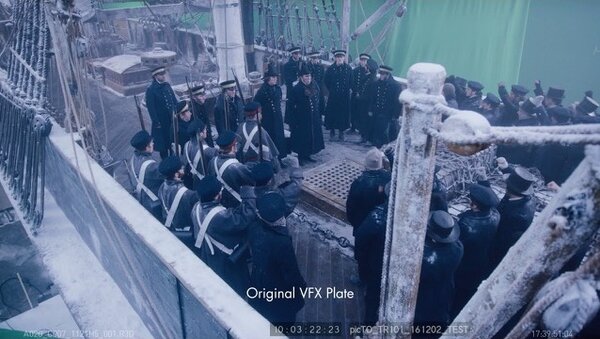
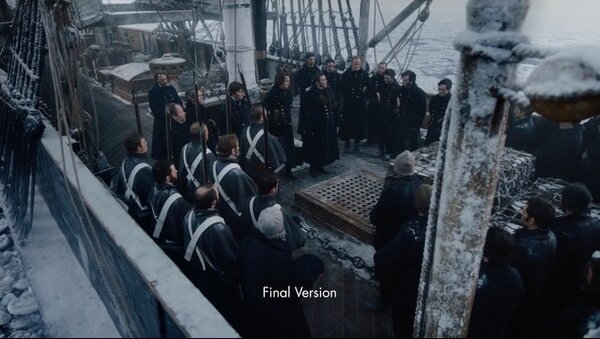
The camera is often in motion, but doesn’t seem to be carried, as is often the case in submarine or ship movies...
FH: Given the tight spaces on set and the realism we were trying to create, logic pushed us towards a shoulder cam, and the immediate authenticity and humanity it creates on the image. But while we were preparing, and as we began to take possession of the nearly-finished set, we suddenly wanted to create something more brutal, in order to increase the feeling of claustrophobia. That’s why, from the first episode, we began to work almost entirely with a miniaturized dolly (the Cobra Dolly), with the help of our ingenious grips. Remembering my past work with director Terrence Davies, who really likes long takes, I also tried to suggest to Edward Berger that he not cut too much. A good example is the reunion scene between the officers, during the first episode, when they are telling one another about their memories from other expeditions. In order to create that establishing shot, we had to suspend the camera by removing the ceiling from that part of the boat and use a remote-controlled gyro-stabilized head. We perfected the movement of the slow crane plunging towards the table and then panning 360° on the actors around the table.
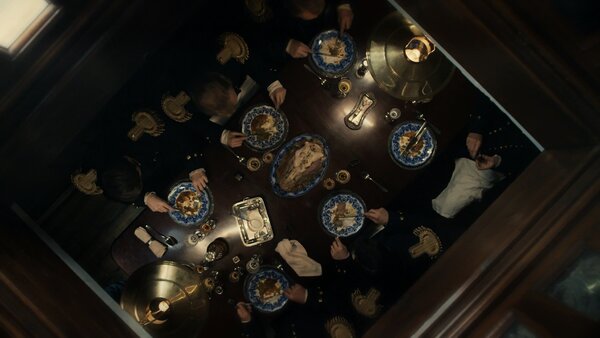
We also used the Technocrane a lot for outdoor shots around the ship, and I must make particular mention of the work of the digital FX team, which allowed us to add ice or ocean in the stead of the immense green screens that were plastered all over the set. The entire opening sequence during which we discover both ships and the air shot behind the Erebus’ keel were shot entirely in our hangar, without a single drop of water. The result is stupefying, and I am extremely grateful to Viktor Muller, the VFX supervisor (Blade Runner 2049, The Walk, Wonder Woman...).
(Interview conducted by François Reumont for the AFC, and translated from French by Alexander Baron-Raiffe)
 En
En
 Fr
Fr








